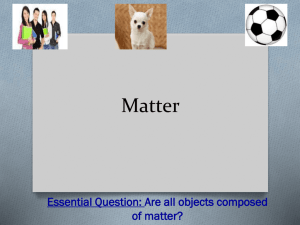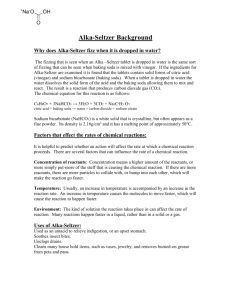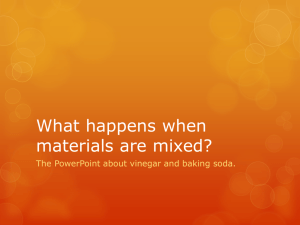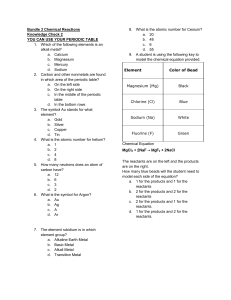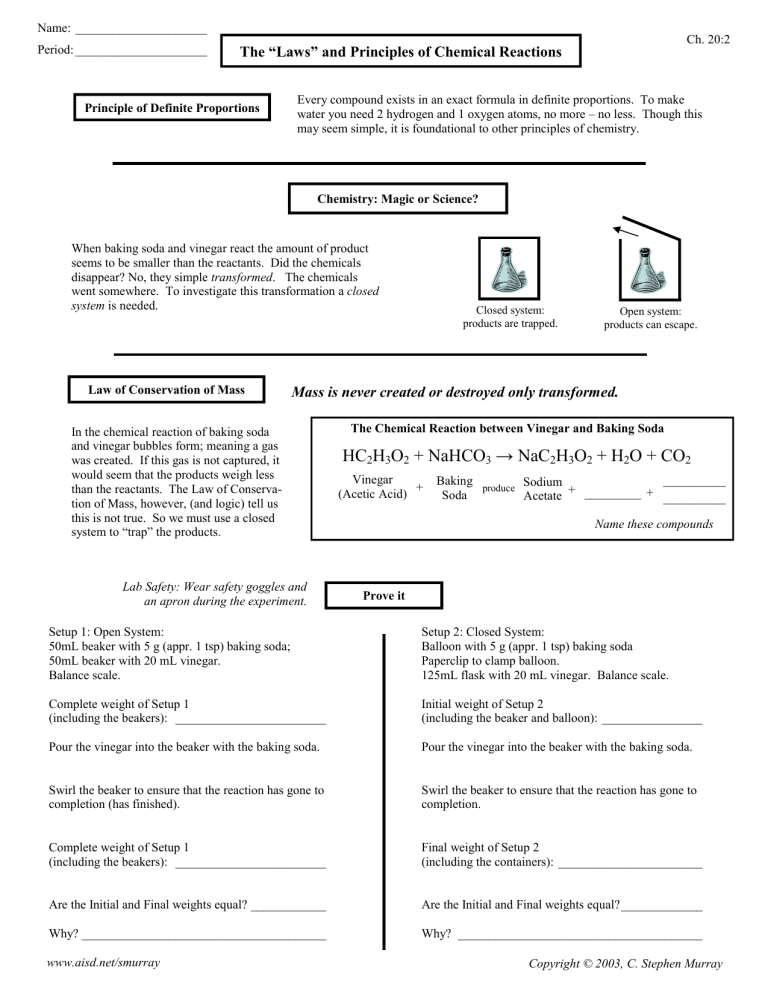
Name: _____________________ Period: _____________________ Ch. 20:2 The “Laws” and Principles of Chemical Reactions Principle of Definite Proportions Every compound exists in an exact formula in definite proportions. To make water you need 2 hydrogen and 1 oxygen atoms, no more – no less. Though this may seem simple, it is foundational to other principles of chemistry. Chemistry: Magic or Science? When baking soda and vinegar react the amount of product seems to be smaller than the reactants. Did the chemicals disappear? No, they simple transformed. The chemicals went somewhere. To investigate this transformation a closed system is needed. Law of Conservation of Mass Closed system: products are trapped. Open system: products can escape. Mass is never created or destroyed only transformed. In the chemical reaction of baking soda and vinegar bubbles form; meaning a gas was created. If this gas is not captured, it would seem that the products weigh less than the reactants. The Law of Conservation of Mass, however, (and logic) tell us this is not true. So we must use a closed system to “trap” the products. Lab Safety: Wear safety goggles and an apron during the experiment. The Chemical Reaction between Vinegar and Baking Soda HC2H3O2 + NaHCO3 → NaC2H3O2 + H2O + CO2 Vinegar + (Acetic Acid) __________ Baking Sodium produce Soda Acetate + _________ + __________ Name these compounds Prove it Setup 1: Open System: 50mL beaker with 5 g (appr. 1 tsp) baking soda; 50mL beaker with 20 mL vinegar. Balance scale. Setup 2: Closed System: Balloon with 5 g (appr. 1 tsp) baking soda Paperclip to clamp balloon. 125mL flask with 20 mL vinegar. Balance scale. Complete weight of Setup 1 (including the beakers): ________________________ Initial weight of Setup 2 (including the beaker and balloon): ________________ Pour the vinegar into the beaker with the baking soda. Pour the vinegar into the beaker with the baking soda. Swirl the beaker to ensure that the reaction has gone to completion (has finished). Swirl the beaker to ensure that the reaction has gone to completion. Complete weight of Setup 1 (including the beakers): ________________________ Final weight of Setup 2 (including the containers): _______________________ Are the Initial and Final weights equal? ____________ Are the Initial and Final weights equal?_____________ Why? _______________________________________ Why? _______________________________________ www.aisd.net/smurray Copyright © 2003, C. Stephen Murray Name: _____________________ Ch. 20:2 Period: _____________________ Balancing Equations H2 + O2 → H2O Find the molecular masses of both sides of this reaction. Mass of reactants: Mass of product: The mass of the reactants and products are not the same, but the Law of Conservation of Mass says that they must be. So we must balance the equation. How to Balance a Chemical Equation H2 + O2 → H2O 1. Count up the number of atoms of each element on each side: 2H 2. Put a coefficient in front of one of the molecules that has too few atoms. H2 + O2 → 2H2O 3. Recount and see if the reaction is balanced. 2H 4. Put a coefficient in front of another molecule that has too few atoms. 5. Recount and see if the reaction is balanced. 6. Finished. 2O 2O 2 H and 1 O 4 H and 2 O 2H2 + O2 → 2H2O 4H 2O 4 H and 2 O 2H2 + O2 → 2H2O Not balanced: not enough oxygens on the product side. Not balanced: not enough hydrogens on the reactant side. Balanced: equal number of atoms on both sides. Balanced Chemical Equation Balancing chemical equations can be a long process depending on how difficult the equations are. Go step-by-step and eventually you will balance the equation. Balance the following Chemical Equations (put 1’s if no other number is needed) __ Al + __ Br2 → __ AlBr3 __ CH4 + __ O2 → __ CO2 + __ H2O __ HCl + __ CaCO3 → __ CaCl2 + __ CO2 + __ H2O www.aisd.net/smurray Copyright © 2003, C. Stephen Murray
